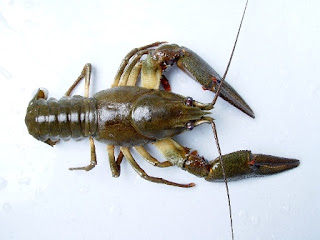 |
| Astacus Astacus |
European Crayfish
Noble Crayfish
Broad-Fingered Crayfish
Synonym : Astacus fluviatilis
Kingdom: Animalia
Phylum: Arthropoda
Subphylum: Crustacea
Class: Malacostraca
Order: Decapoda
Family: Astacidae
Genus: Astacus
Species: Astacus Astacus
Common Name Astacus Astacus :
English – Noble Crayfish, Broad-clawed Crayfish, Broad-fingered Crayfish, European Crayfish, Red-clawed Crayfish, Red-footed Crayfish, River Crayfish
French – Écrevisse á Pattes Rouges, Écrevisse Fluviatile, Écrevisse Noble
Size Length of male: 16 cm
Length of female: 12 cm
Astacus (from the Greek αστακός, astacós, meaning "Lobster" or "Crayfish"/"Crawfish") is a genus of Crayfish found in Europe and western Asia, comprising three extant and four extinct species.
Due to the American crayfish plague, crayfish of this genus have been almost wiped out in Europe and have in many European countries been replaced by the North American signal crayfish, which is often more resistant to the plague
Astacus Astacus, the "European Crayfish", "Noble Crayfish" or "Broad-Fingered Crayfish", is the most common species of crayfish in Europe, and a traditional foodstuff. Like other crayfish, Astacus Astacus is restricted to fresh water, living only in unpolluted streams, rivers and lakes. It is found from France throughout Central Europe, to the Balkan peninsula, and north as far as parts of the British Isles, Scandinavia, and the western parts of the former Soviet Union. Males may grow up to 16 cm long, and females up to 12 cm.
The Noble Crayfish, Astacus Astacus, is indigenous and widespread throughout Europe. This species range extends from Russia and the Ukraine in the east, to Finland, Sweden, Norway in the north, to Greece in the south, and the United Kingdom and France in the west. A few recently introduced subpopulations are found outside Europe, for example Morocco. The occurrence of this species within Andorra, Cyprus, the UK, Liechtenstein, Luxembourg, Morocco and possibly Montenegro and Italy, is via introductions from neighbouring countries.
Astacus Astacus was once abundant in Europe, although it was expensive to buy, and is considered to be the finest edible crayfish. It is, however, susceptible to the crayfish plague carried by the invasive American species signal crayfish (Pacifastacus leniusculus), and is therefore listed as a vulnerable species on the IUCN Red List.
Documentation of the consumption of Astacus Astacus dates back to the Middle Ages, when it was popular among the Swedish nobility, spreading to all social classes by the 17th and 18th centuries due to its ready availability. The crayfish are collected from the wild in traps, a practice which is being replaced by more intensive aquaculture of the signal crayfish in man-made ponds. The consumption of crayfish is an important part of traditional Scandinavian culture, including the crayfish party or kräftskiva, a feast to mark the end of summer
Native Astacus Astacus :
Andorra; Austria; Belarus; Belgium; Bosnia and Herzegovina; Bulgaria; Croatia; Czech Republic; Denmark; Estonia; Finland; France; Germany; Greece; Hungary; Latvia; Lithuania; Macedonia, the former Yugoslav Republic of; Moldova; Netherlands; Poland; Romania; Russian Federation (Kaliningrad); Serbia; Slovakia; Slovenia; Switzerland
Astacus Astacus varies in colour from green or blue to brown and sometimes black. The undersides of the claws are dark red. The head and internal organs of all crayfish are protected by the carapace and the six segments of the abdomen are individually encased with a flexible membrane between them to allow movement. Crayfish have a pair of large claws at the front end, followed by four pairs of walking legs and then four pairs of small swimming legs called swimmerets. These swimmerets are covered with fine hairs to which the female attaches her eggs. A central tail flap is surrounded by four other flaps that are used to move the crayfish rapidly through the water, as well as curling up to form a brood chamber. There are two eyes on the end of eyestalks, but the senses of touch and taste are far more important, and are perceived using a pair of large feelers (or antennae) and a pair of small, fine, centrally located feelers (or antennules).
 |
| Astacus Astacus Male |
 |
| Astacus Astacus Female |
 |
| Astacus Astacus |
 |
| Astacus Astacus |
 |
| Astacus Astacus |
 |
| Astacus Astacus |













0 comments:
Post a Comment